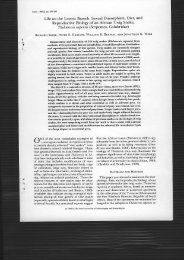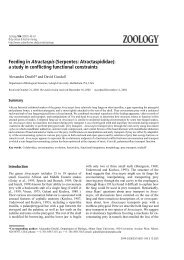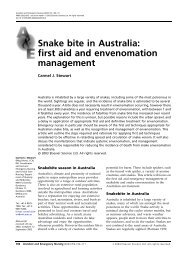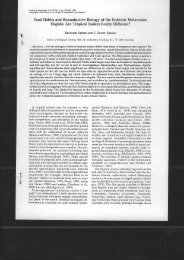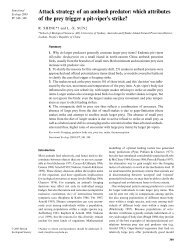Introduction - Kingsnake.com
Introduction - Kingsnake.com
Introduction - Kingsnake.com
You also want an ePaper? Increase the reach of your titles
YUMPU automatically turns print PDFs into web optimized ePapers that Google loves.
Clinical Management of Snakebite in Papua New Guinea Chapter 1<br />
Epidemiology of snakebite in PNG<br />
Although the first published medical report of snakebite in Papua New Guinea did not appear<br />
in the literature until 1961, the risk to public health presented by venomous snakes was well<br />
known, and snakes generally were (and remain) widely feared.<br />
While the Papua New Guinean perception of snakebite may have revolved around the<br />
traditional beliefs of the various cultural and social groups throughout the country, the<br />
perceptions of colonial medical officers was tempered by ‘western’ attitudes which had by the<br />
start of the 20 th Century largely turned away from belief in supernatural forces towards<br />
acceptance of ‘scientific’ conclusions that were based on rational hypotheses, demonstrable<br />
facts and clinical reality. Significant advances in human understanding of basic physiology<br />
and biology provided a vastly different perspective of the causes of the clinical effects seen<br />
after snakebite. Rather than being considered as the result of sorcery, colonial doctors had a<br />
strong belief that snakebite was the consequence of the physiological changes produced by<br />
organic toxins.<br />
Over the last 5 decades there has been considerable interest in the problems associated with<br />
snakebite in PNG, and a number of epidemiological and clinical studies, aimed at learning<br />
more about the consequences of snakebite and the out<strong>com</strong>es of various treatment strategies,<br />
have been carried out. As a result there exists a considerable body of information to help us in<br />
understanding why snakebite occurs, what the consequences may be, and what we should be<br />
doing to improve the prognosis for snakebite patients.<br />
Incidence and Mortality Rates<br />
Early publications about snakebite in Papua New Guinea give no data on the overall incidence<br />
of morbidity or mortality, and concentrate predominantly on the reporting of case series that<br />
describe clinical syndromes of envenoming and their treatment. Campbell & Young (1961)<br />
reported 15 cases of serious envenoming from Central province between November 1959 and<br />
August 1960. The single death in this series was due to pulmonary oedema. Campbell (1964)<br />
reported an additional 41 cases in addition to further discussion of 11 cases from the earlier<br />
study. All of these cases occurred between mid-February 1960 and September 1962, with 38<br />
cases originating within 80 kilometres of Port Moresby. As with the earlier paper, no data is<br />
presented to explain whether these represent all of the cases treated, or whether they only<br />
represent cases treated by the author.<br />
Campbell also published three papers describing clinical syndromes of envenoming by<br />
presumed death adders Acanthophis antarcticus 1 (1966), Papuan taipans Oxyuranus<br />
scutellatus canni (1967a), and Papuan blacksnakes Pseudechis papuanus (1967c), but again<br />
gives no indications as to whether the cases reported represent all cases during particular<br />
periods, or are simply representative case histories. None of the cases were fatal. In a report<br />
on antivenom use Campbell (1967b) records a case fatality rate of 7.1% from 28 cases treated<br />
over a 21 month period from March 1964 to November 1965. In discussing the management<br />
of 73 cases between 1959 and 1965, Campbell (1969a) records 5 fatalities (CFR of 6.8%).<br />
Campbell (1969b) recorded mean admissions for snakebite in Papuan hospitals as 155.5 cases<br />
per annum for the period 1961-1967, and says that there were 6.3 admissions for snakebite per<br />
1,000 patients (0.63%).<br />
1 Acanthophis antarcticus is not currently believed to occur in Papua New Guinea, and ongoing taxonomic<br />
investigations suggest that the genus is represented by several distinct species including Acanthophis rugosus<br />
and Acanthophis laevis.<br />
- 1.7 -




